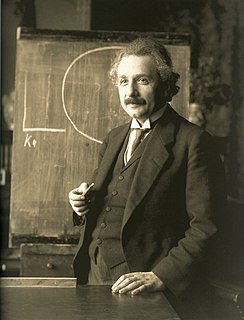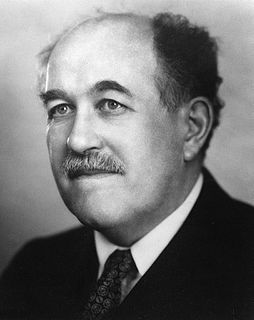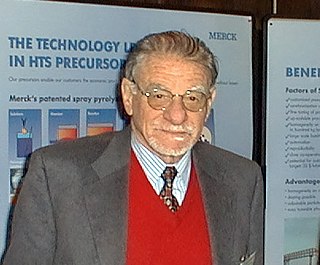
Albert Einstein was a German-born theoretical physicist, widely acknowledged to be one of the greatest and most influential physicists of all time. Einstein is best known for developing the theory of relativity, but he also made important contributions to the development of the theory of quantum mechanics. Relativity and quantum mechanics are the two pillars of modern physics. His mass–energy equivalence formula E = mc2, which arises from relativity theory, has been dubbed "the world's most famous equation". His work is also known for its influence on the philosophy of science. He received the 1921 Nobel Prize in Physics "for his services to theoretical physics, and especially for his discovery of the law of the photoelectric effect", a pivotal step in the development of quantum theory. His intellectual achievements and originality resulted in "Einstein" becoming synonymous with "genius".

Wolfgang Ernst Pauli was an Austrian theoretical physicist and one of the pioneers of quantum physics. In 1945, after having been nominated by Albert Einstein, Pauli received the Nobel Prize in Physics for his "decisive contribution through his discovery of a new law of Nature, the exclusion principle or Pauli principle". The discovery involved spin theory, which is the basis of a theory of the structure of matter.

Max Born was a German physicist and mathematician who was instrumental in the development of quantum mechanics. He also made contributions to solid-state physics and optics and supervised the work of a number of notable physicists in the 1920s and 1930s. Born won the 1954 Nobel Prize in Physics for his "fundamental research in quantum mechanics, especially in the statistical interpretation of the wave function".

ETH Zurich is a public research university in the city of Zürich, Switzerland. Founded by the Swiss Federal Government in 1854 after the model of the École polytechnique in Paris with the stated mission to educate engineers and scientists, the school focuses primarily on science, technology, engineering, and mathematics. Like its sister institution EPFL, it is part of the Swiss Federal Institutes of Technology Domain, part of the Swiss Federal Department of Economic Affairs, Education and Research.

Yang Chen-Ning or Chen-Ning Yang, also known as C. N. Yang or by the English name Frank Yang, is a Chinese theoretical physicist who made significant contributions to statistical mechanics, integrable systems, gauge theory, and both particle physics and condensed matter physics. He and Tsung-Dao Lee received the 1957 Nobel Prize in Physics for their work on parity non-conservation of weak interaction. The two proposed that one of the basic quantum-mechanics laws, the conservation of parity, is violated in the so-called weak nuclear reactions, those nuclear processes that result in the emission of beta or alpha particles. Yang is also well known for his collaboration with Robert Mills in developing non-abelian gauge theory, widely known as the Yang–Mills theory.

Mileva Marić, sometimes called Mileva Marić-Einstein, was a Serbian physicist and mathematician and the first wife of Albert Einstein from 1903 to 1919. She was the only woman among Einstein's fellow students at Zürich Polytechnic and was the second woman to finish a full program of study at the Department of Mathematics and Physics. Marić and Einstein were collaborators and lovers and had a daughter Lieserl in 1902, whose fate is unknown. They later had two sons, Hans Albert and Eduard.

The year 1905 in science and technology involved some significant events, particularly in physics, listed below.

Otto Stern was a German-American physicist and Nobel laureate in physics. He was the second most nominated person for a Nobel Prize with 82 nominations in the years 1925–1945, ultimately winning in 1943.

The year 2005 was named the World Year of Physics, also known as Einstein Year, in recognition of the 100th anniversary of Albert Einstein's "Miracle Year", in which he published four landmark papers, and the subsequent advances in the field of physics.
Annus mirabilis is a Latin phrase that means "marvelous year", "wonderful year", "miraculous year", or "amazing year". This term has been used to refer to several years during which events of major importance are remembered, notably Isaac Newton's discoveries in 1666.

Marcel Grossmann was a Swiss mathematician and a friend and classmate of Albert Einstein. Grossmann was a member of an old Swiss family from Zurich. His father managed a textile factory. He became a Professor of Mathematics at the Federal Polytechnic School in Zurich, today the ETH Zurich, specializing in descriptive geometry.
The year 2005 in science and technology involved some significant events.

General relativity is a theory of gravitation that was developed by Albert Einstein between 1907 and 1915, with contributions by many others after 1915. According to general relativity, the observed gravitational attraction between masses results from the warping of space and time by those masses.

The annus mirabilis papers are the four papers that Albert Einstein published in Annalen der Physik, a scientific journal, in 1905. These four papers were major contributions to the foundation of modern physics. They revolutionized science's understanding of the fundamental concepts of space, time, mass, and energy. Because Einstein published these remarkable papers in a single year, 1905 is called his annus mirabilis.

Alfred Kleiner was a Swiss physicist and Professor of Experimental Physics at the University of Zurich. He was Albert Einstein's doctoral advisor or Doktorvater. Initially Einstein's advisor was Heinrich F. Weber. However, they had a major falling out, and Einstein chose to switch to Kleiner.

Karl Alexander Müller is a Swiss physicist and Nobel laureate. He received the Nobel Prize in Physics in 1987 with Georg Bednorz for their work in superconductivity in ceramic materials.

Pierre-Ernest Weiss was a French physicist who specialized in magnetism. He developed the domain theory of ferromagnetism in 1907. Weiss domains and the Weiss magneton are named after him. Weiss also developed the molecular or mean field theory, which is often called Weiss-mean-field theory, that led to the discovery of the Curie–Weiss law. Alongside Auguste Picard, Pierre Weiss is considered one of the first discoverers of the magnetocaloric effect in 1917.
The following outline is provided as an overview of and topical guide to Albert Einstein: